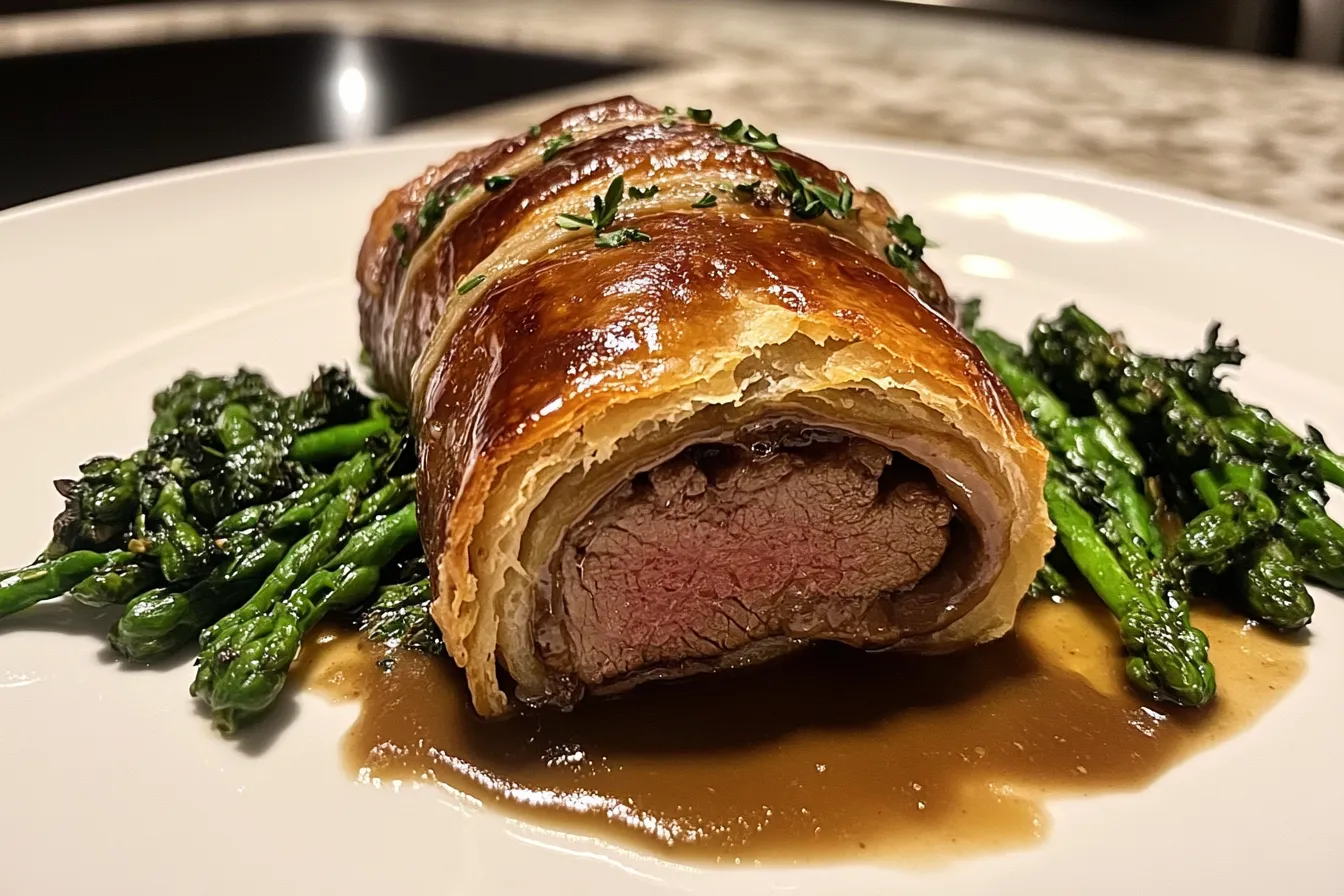Have you ever dreamed of serving a show-stopping Beef Wellington but felt intimidated by its reputation as a “difficult” dish? You’re not alone! Beef Wellington is a culinary masterpiece, but nailing it comes down to a few key secrets that can make all the difference. From achieving perfectly cooked beef to ensuring a golden, flaky crust, these tips will help you avoid common pitfalls and create a dish worthy of any special occasion. I remember my first attempt—I was so nervous about the pastry getting soggy or the beef overcooking, but with a few simple tricks, everything came together beautifully. If you’ve ever hesitated to try this classic dish, let’s uncover the secrets to a perfect Beef Wellington so you can tackle it with confidence!
List Of Contents
What Is Beef Wellington?
Beef Wellington is one of the most iconic dishes in the world of gourmet cuisine. Its layers of tender beef, earthy mushroom duxelles, and golden, flaky pastry have secured its place as a showstopper for any special occasion. Whether you’re looking to impress at a dinner party or simply enjoy a culinary adventure, mastering Beef Wellington is well worth the effort. Check out more recipes here.
1. Introduction to Beef Wellington
Beef Wellington is a classic British dish consisting of a tender cut of beef, typically tenderloin, coated with mushroom duxelles, wrapped in prosciutto, and encased in puff pastry before being baked to perfection.
- Historical Background: Although its exact origins are debated, many believe it was named after the Duke of Wellington, a celebrated British military hero. The dish embodies luxury and elegance, often associated with fine dining and celebratory meals. Check out more recipes here.
- Why It’s a Classic: Beef Wellington is revered not just for its taste but for the skill and precision it demands. From achieving the perfect sear on the beef to wrapping it seamlessly in pastry, it’s a culinary challenge that rewards the effort with a truly decadent experience. Check out more recipes here.
2. Key Components of Beef Wellington
To craft the perfect Beef Wellington, it’s essential to understand the role of its key ingredients:
- Beef: The star of the dish, typically tenderloin, prized for its tenderness and rich flavor.
- Duxelles: A savory mixture of finely chopped mushrooms, shallots, and herbs, cooked until dry to add depth of flavor.
- Puff Pastry: Provides a crispy, golden shell that contrasts beautifully with the soft beef inside.
- Prosciutto: Acts as a barrier to prevent the pastry from becoming soggy and adds a salty, umami punch.
Each component is vital to creating a dish that’s as visually stunning as it is delicious. Check out more recipes here.
3. Selecting the Right Cut of Beef
The choice of beef is critical to a successful Wellington.
- Ideal Cuts: Tenderloin or filet mignon are the best options due to their soft texture and uniform shape. The even thickness ensures consistent cooking.
- What to Look For: High-quality beef should have a bright red color, fine marbling, and firm texture. Always opt for grass-fed or organic cuts for superior flavor.
4. Importance of the Pastry
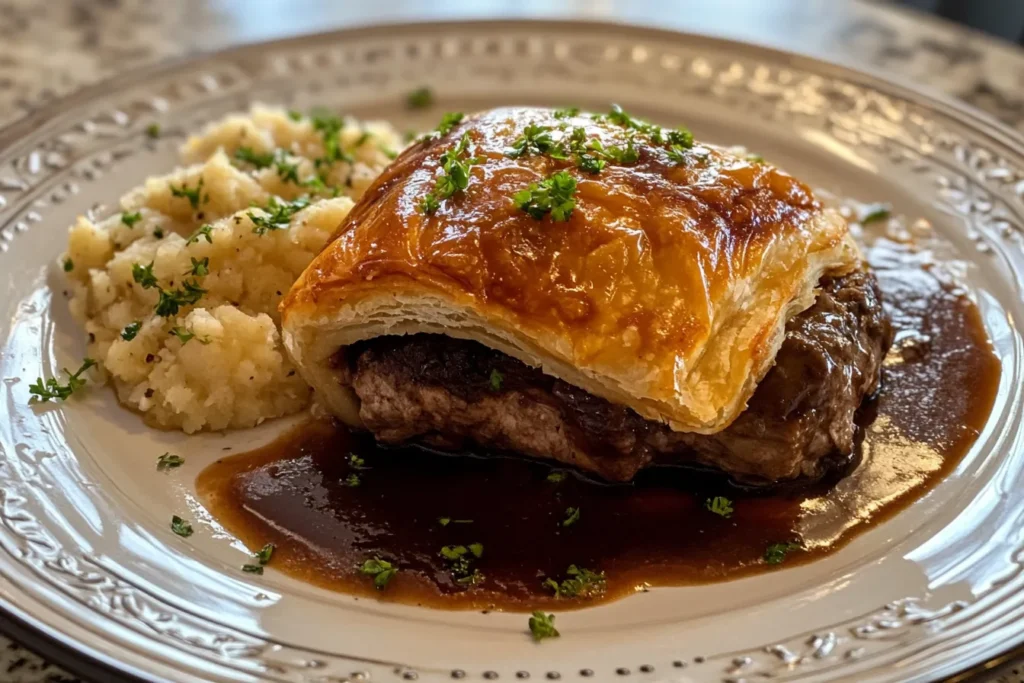
The puff pastry is more than just a wrapping—it’s a crucial element that contributes to the dish’s visual appeal and texture.
- Why Puff Pastry: It’s light, flaky, and buttery, complementing the rich beef and duxelles.
- Pro Tips:
- Keep the pastry cold to maintain its structure.
- Brush with an egg wash for a glossy, golden finish.
- Use a lattice cutter or score the surface for a decorative touch.
5. The Role of Duxelles
Duxelles is a finely chopped mixture of mushrooms, shallots, garlic, and herbs, cooked until the moisture evaporates.
- How It Enhances the Dish: The earthy flavors of mushrooms pair perfectly with beef, while the dry texture ensures the pastry stays crisp.
- Preparation Tips:
- Use a food processor for even chopping.
- Enhance the flavor with a hint of dry white wine or a subtle splash of sherry for added complexity and richness.
- Incorporate thyme or tarragon for aromatic complexity.
6. Prosciutto Layering
Wrapping the beef in prosciutto before encasing it in pastry serves multiple purposes:
- Keeps the Pastry Dry: Prosciutto acts as a barrier, preventing moisture from the beef or duxelles from soaking into the pastry.
- Enhances Flavor: Its salty, smoky taste adds an extra layer of complexity.
- Alternatives: For a twist, use serrano ham or even thinly sliced pancetta.
7. Timing and Temperature
Precise timing is essential to avoid overcooking or undercooking the beef.
- Key Tips:
- Utilise a meat thermometer to precisely track the internal temperature and ensure perfect doneness every time. Aim for 125°F (52°C) for medium-rare before resting.
- Chill the assembled Wellington before baking to ensure the pastry doesn’t overcook before the beef is done.
8. Resting the Meat
Allowing the Beef Wellington to rest after baking is a step you can’t skip.
- Why Resting Matters: It lets the juices redistribute throughout the beef, ensuring every slice is moist and flavorful.
- How Long to Rest: Let the Wellington sit for at least 10–15 minutes before slicing.
9. Achieving a Flawless Assembly
The assembly process can make or break your Beef Wellington.
- Layering Techniques: Start with prosciutto, add a layer of duxelles, and then wrap everything tightly around the beef.
- Pro Tips:
- Use cling film to shape the wrapped beef into a uniform log.
- Refrigerate the log before encasing it in pastry to make handling easier.
10. Secrets to Perfect Searing
Before wrapping the beef, searing it is crucial to develop flavor and lock in moisture.
- Why It’s Important: Searing creates a caramelized crust that enhances the overall taste.
- Tips for Success:
- Pat the beef dry before searing.
- Use a cast-iron skillet for even heat distribution.
- Avoid over-searing—aim for a quick, even browning on all sides.
Advanced Techniques and Customizations
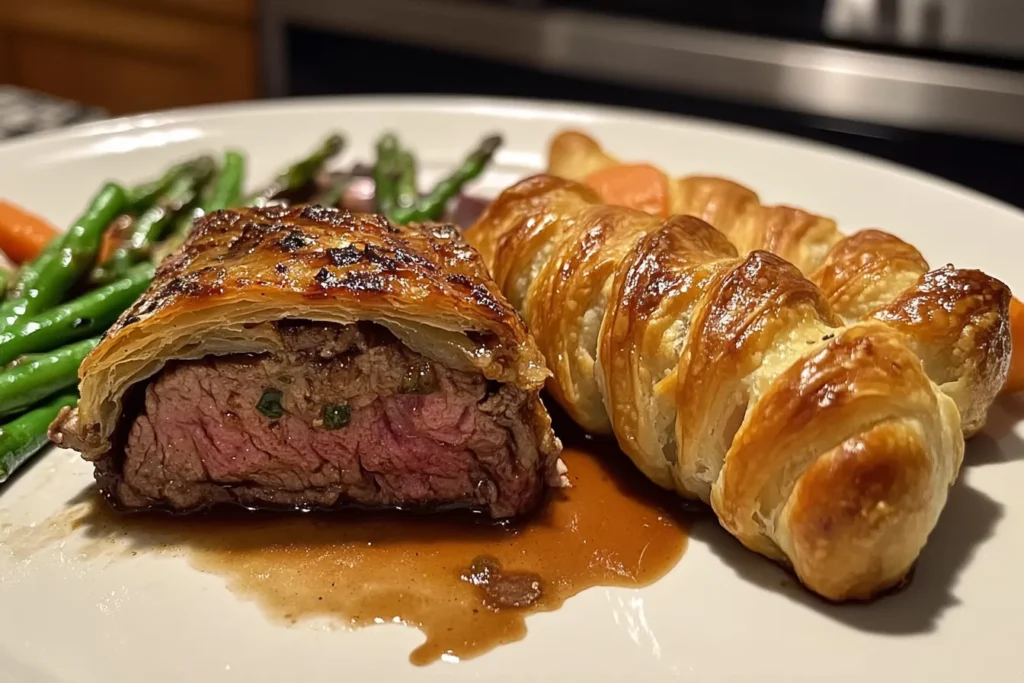
11. Preparing Puff Pastry from Scratch
While store-bought puff pastry is a convenient option, making it from scratch can take your Beef Wellington to the next level.
- Why Homemade Pastry Shines:
- It allows for customization in terms of texture and flavor.
- Freshly made puff pastry is typically lighter and more buttery.
- Step-by-Step Guide:
- Mix cold butter, flour, and a pinch of salt.
- Add chilled water to form a dough, then roll it out into a rectangle.
- Fold the dough into thirds, chill, and repeat the process several times to create layers.
- Enhancing Store-Bought Pastry: If making pastry isn’t feasible, brush store-bought puff pastry with a thin layer of butter or sprinkle with grated parmesan for extra richness.
12. Adding Depth with Additional Flavors
Enhancing the flavor profile of your Beef Wellington can make it truly gourmet.
- Incorporate Truffle Oil: Add a few drops of truffle oil to the duxelles or brush it onto the beef before wrapping.
- Pâté for Richness: A thin layer of pâté, such as foie gras or chicken liver pâté, can be spread on top of the prosciutto for an indulgent twist.
- Herb-Infused Pastry: Mix finely chopped rosemary, thyme, or sage into the puff pastry dough to complement the dish’s earthy flavors.
13. Common Mistakes to Avoid
Even experienced chefs can run into pitfalls when preparing Beef Wellington. Here’s how to sidestep the most common issues:
- Overcooking the Beef: Use a meat thermometer to ensure precise doneness. Remember, the beef will continue to cook slightly during the resting period.
- Soggy Pastry: Avoid this by ensuring the duxelles is cooked until completely dry and chilling the assembled Wellington before baking.
- Imbalanced Flavors: Taste each component individually to ensure seasoning is balanced before assembly.
14. Cooking Methods Compared
The traditional oven-baked method isn’t the only way to cook Beef Wellington. Here are some modern alternatives:
- Sous-Vide:
- Cook the beef sous-vide before searing for ultimate tenderness and precise doneness.
- Be sure to dry the beef thoroughly after sous-vide cooking to avoid soggy pastry.
- Air Fryer:
- Ideal for smaller, individual Wellingtons.
- Provides a crispy pastry while using less energy than a conventional oven.
15. Pairing Side Dishes
The rich, savory flavors of Beef Wellington are best complemented by simple, elegant side dishes:
- Vegetables:
- Roasted asparagus or Brussels sprouts.
- Glazed carrots for a touch of sweetness.
- Starches:
- Creamy mashed potatoes or dauphinoise potatoes.
- A light potato galette adds texture.
- Sauces:
- A classic red wine reduction enhances the beef’s flavor.
- Mushroom or truffle cream sauce provides a luxurious pairing.
16. Beef Wellington for Special Diets
With a few modifications, you can adapt Beef Wellington to suit different dietary needs:
- Vegetarian:
- Replace the beef with a roasted whole portobello mushroom or a vegetable medley.
- Use a mushroom-based duxelles and skip the prosciutto.
- Vegan:
- Substitute puff pastry with vegan-friendly versions.
- Swap butter and cream in the duxelles for plant-based alternatives.
- Use marinated tofu or seitan as the protein.
- Gluten-Free:
- Opt for gluten-free pastry options, which are now widely available.
- Ensure other components, like sauces, are thickened with cornstarch instead of flour.
17. Presentation and Plating Tips
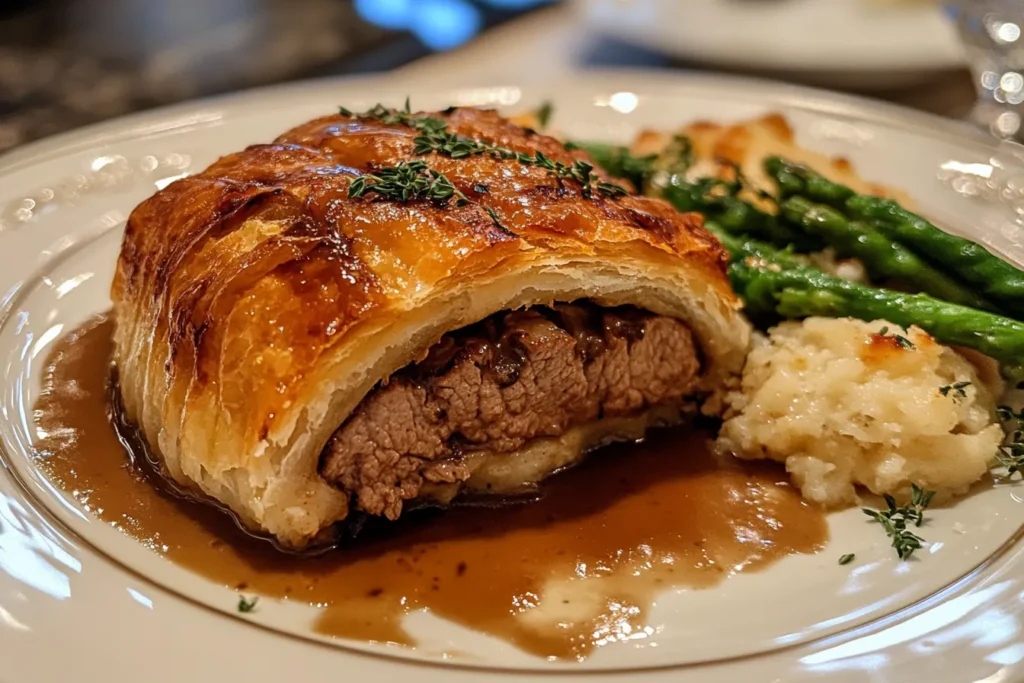
The visual appeal of Beef Wellington is almost as important as its taste. Follow these tips for stunning presentation:
- Perfect Slices: Use a sharp, serrated knife to cut clean, even slices without tearing the pastry.
- Plating Ideas:
- Place each slice atop a pool of sauce for a professional touch.
- Decorate with vibrant fresh herbs or delicate edible flowers to enhance the presentation with a burst of color.
18. Secrets from Professional Chefs
Top chefs have mastered Beef Wellington by following these insider tricks:
- From Gordon Ramsay: Freeze the beef briefly after searing to help maintain its shape during assembly and cooking.
- Consistent Layers: Ensure the duxelles is spread in an even layer to prevent uneven cooking or sogginess.
- High-Heat Blast: Start the Wellington in a very hot oven (around 425°F/220°C) for the first 10–15 minutes to crisp up the pastry quickly, then reduce the heat to finish cooking.
19. Troubleshooting Beef Wellington
Sometimes things don’t go as planned, but these fixes can save your dish:
- Undercooked Beef: Return slices to the oven for a few minutes on a baking tray.
- Overcooked Pastry: Cover the Wellington loosely with foil during baking to avoid excessive browning.
- Cracked Pastry: Patch small cracks with leftover pastry dough and brush with egg wash.
20. Creating Mini Beef Wellingtons
Individual portions of Beef Wellington are perfect for dinner parties or appetizers.
- Benefits:
- Easier to serve and ensure everyone gets an equal portion.
- Faster cooking times compared to a full-sized Wellington.
- Tips for Mini Versions:
- Use smaller cuts of beef, like medallions.
- Adjust the cooking time to about 15–20 minutes, depending on the size.
21. Classic Beef Wellington Recipe
Here’s a tried-and-true recipe to create a traditional Beef Wellington that will wow your guests.
Ingredients:
- 1 beef tenderloin (approximately 2 lbs)
- 1 lb puff pastry (homemade or store-bought)
- 8 oz mushrooms (button or cremini), finely chopped
- 2 shallots, minced
- 4 garlic cloves, minced
- 6 slices of prosciutto
- 2 tbsp Dijon mustard
- 2 tbsp olive oil
- 1 egg (beaten, for egg wash)
- Salt and freshly ground black pepper
- Optional: 1 tbsp truffle oil or pate for extra flavor
Instructions:
- Sear the Beef:
- Season the beef generously with salt and pepper.
- Warm olive oil in a skillet and quickly sear the beef on all sides to achieve a rich, golden-brown crust. Let cool and brush with Dijon mustard.
- Prepare the Duxelles:
- Sauté mushrooms, shallots, and garlic in olive oil until dry. Season with salt, pepper, and optional truffle oil. Set aside to cool.
- Assemble Layers:
- Lay prosciutto slices overlapping on plastic wrap. Spread the cooled duxelles over the prosciutto.
- Place the beef in the center, then roll tightly using the plastic wrap. Chill for 20–30 minutes.
- Wrap in Pastry:
- Roll out the puff pastry and remove plastic wrap from the beef roll. Place the beef in the center of the pastry and fold over, sealing the edges.
- Bake:
- Brush the pastry with egg wash and make small decorative cuts on the surface.
- Bake at 425°F (220°C) for 10 minutes, then reduce to 375°F (190°C) and cook for an additional 20–25 minutes until golden brown.
- Rest and Serve:
- Let the Wellington rest for 10 minutes before slicing.
22. Gourmet Beef Wellington Variations
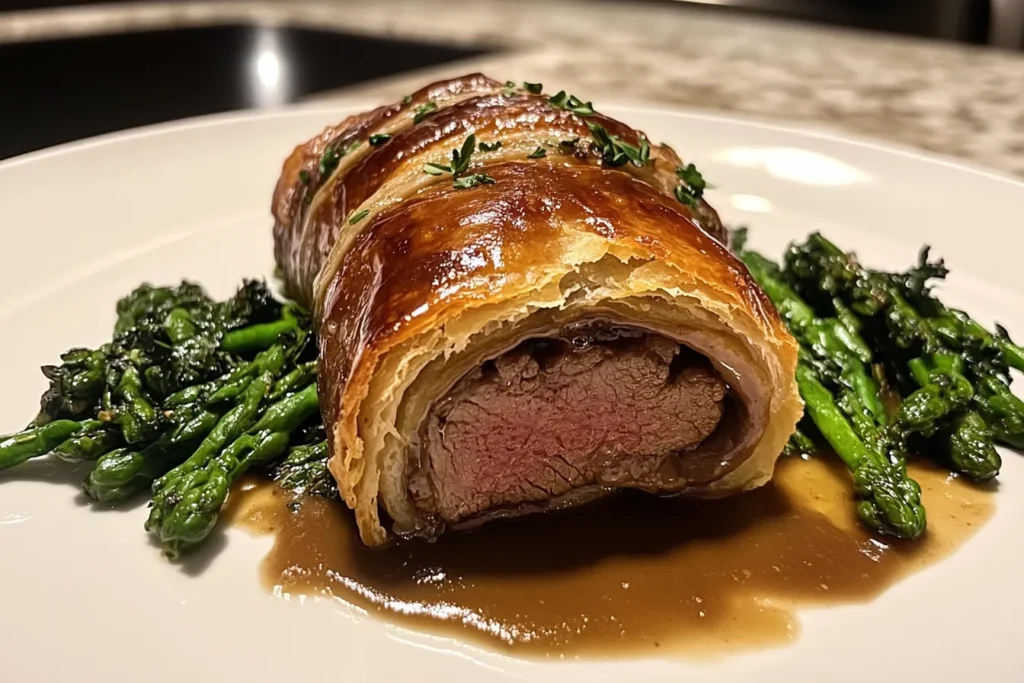
Elevate the traditional recipe with these luxurious additions:
- Foie Gras: Spread a thin layer of foie gras on top of the prosciutto for a decadent flavor.
- Black Garlic: Add a few finely chopped cloves to the duxelles for an umami-packed twist.
- Seafood Twist: Replace beef with salmon for a lighter variation that pairs beautifully with dill and cream sauce.
23. Holiday Beef Wellington
Beef Wellington is a showstopper for festive occasions. Here’s how to adapt it for the holidays:
- Festive Garnishing: Use rosemary sprigs, cranberries, or gold leaf for a celebratory touch.
- Port Wine Sauce: Serve with a rich port reduction for an indulgent pairing.
- Mini Wellingtons: These are perfect for buffet-style holiday gatherings.
24. Preparing Beef Wellington in Advance
One of the most challenging aspects of Beef Wellington is its time-intensive preparation. Here’s how to make it easier:
- Make-Ahead Tips:
- Prepare the beef, duxelles, and prosciutto wrap up to a day in advance and refrigerate.
- Wrap in puff pastry just before baking for the freshest results.
- Reheating Without Soggy Pastry: Slice and warm individual portions in the oven at a low temperature (around 250°F/120°C).
25. Cooking for Large Gatherings
Scaling up Beef Wellington for a large party is entirely possible with careful planning.
- Buffet-Style Serving:
- Prepare several smaller Wellingtons instead of one large one for easier portioning.
- Pair with an assortment of sauces so guests can customize their servings.
- Time Management: Pre-assemble the Wellingtons the day before the event to minimize last-minute stress.
26. Budget-Friendly Alternatives
Beef Wellington is a luxurious dish, but you can create a similar experience without breaking the bank.
- Cheaper Cuts: Swap tenderloin for a leaner cut, such as sirloin, and adjust the cooking time to ensure tenderness.
- Mushroom Medley: Use affordable mushrooms like portobello or white button for the duxelles.
- Puff Pastry Alternatives: Use phyllo dough for a lighter, less expensive pastry option.
27. Modern Twists on Beef Wellington
Bring creativity to your Beef Wellington with these exciting twists:
- Fusion Flavors:
- Add spices like cumin and coriander for a Moroccan-inspired version.
- Use teriyaki-glazed beef with sesame oil for an Asian twist.
- Unexpected Proteins:
- Try chicken Wellington with a creamy spinach filling.
- Lobster Wellington offers a decadent seafood alternative.
28. Best Equipment for Beef Wellington
Using the appropriate tools is essential for achieving polished, professional-quality results every time:
- Meat Thermometer: Ensures perfect doneness every time.
- Pastry Brush: For even application of egg wash.
- Mandoline: For precise cutting of thin prosciutto slices or vegetables for garnishing.
29. Hosting a Beef Wellington Dinner Party
When hosting a dinner party with Beef Wellington as the centerpiece, timing and presentation are key.
- Menu Planning:
- Serve lighter starters like a fresh salad or soup to leave room for the main course.
- Choose simple yet elegant desserts, such as panna cotta or crème brûlée.
- Timing Tips:
- Serve immediately after resting for the best flavor and texture.
- Prepare all side dishes in advance to focus solely on slicing and plating the Wellington.
30. Frequently Asked Questions about Beef Wellington
- Why is my puff pastry soggy?
- Ensure the duxelles is fully cooked and moisture-free before assembly.
- Can I use frozen beef?
- It’s better to use fresh beef, but if frozen, thaw it completely and pat it dry before cooking.
- How do I reheat leftovers?
- Warm slices in the oven at a low temperature to retain crispiness.
- What’s the best wine pairing for Beef Wellington?
- A robust red wine like Cabernet Sauvignon or Pinot Noir pairs beautifully.
- Can I use store-bought duxelles?
- Homemade duxelles are best for freshness and flavor, but store-bought can work in a pinch.
- What happens if my pastry cracks?
- Patch with extra pastry dough and egg wash before baking.
- Can I freeze Beef Wellington?
- Yes, freeze the assembled Wellington before baking. Bake directly from frozen, adding 10–15 minutes to the cooking time.
- What’s the ideal thickness for the puff pastry?
- Roll to about 1/8 inch for a light, flaky crust.
- How long can I store uncooked Beef Wellington?
- Up to 24 hours in the refrigerator.
- How do I avoid overcooking the beef?
- Use a meat thermometer and remove the Wellington from the oven when it reaches 125°F (52°C) for medium-rare.
